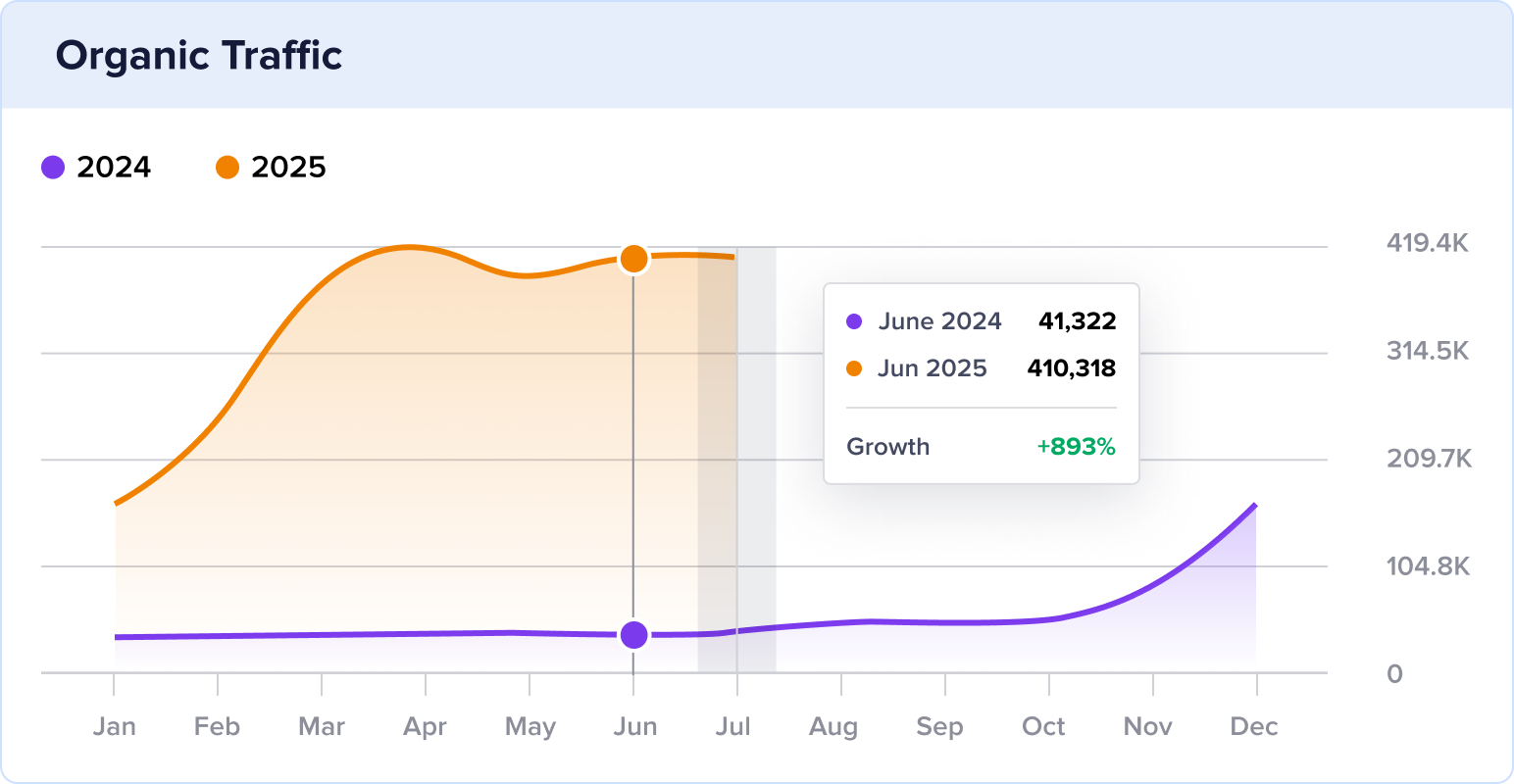How an Office Furniture Manufacturer Grew Traffic by 351% in 6 Months
https://vivo-us.com/
Stats
24.7K to 111.3K Monthly Visits
Industry
Ecommerce & Retail
Niche
Home & Office
Reporting Date
February 2024
VIVO is a manufacturer and online retailer of ergonomic office furniture. Despite being based in the U.S., VIVO caters to a global audience. Some of their most popular products are standing desks and monitor mounts.
In February 2024, VIVO experienced a significant increase in organic traffic. Monthly visits skyrocketed from 24.7K to 111.3K in a short span of 6 months.
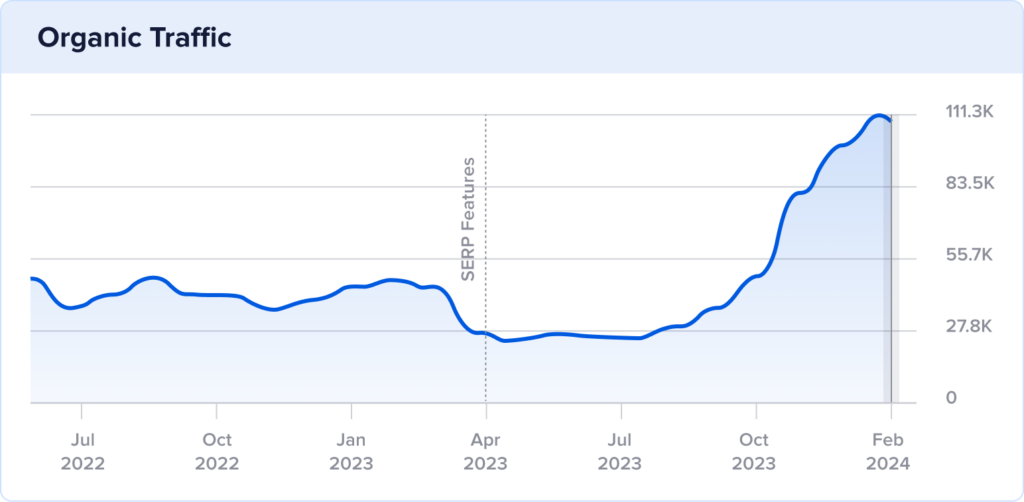
In this SEO case study, we’ll delve into the strategies behind VIVO’s recent digital success. You'll also get tips and tools for replicating their SEO wins on your website.
In This Article
The Catalyst: How VIVO Grew Organic Traffic by 351% in 6 Months
1. Navigating the Ups and Downs of Google Algorithm Updates
If you've been following the world of SEO, you'll know that 2023 brought a wave of algorithm updates.
Many of these occurred in the fall, with September's Helpful Content Update (HCU) creating the most buzz.
For VIVO, this update triggered a boost in rankings.
In the chart below, we see how September’s keyword rankings increased by over 5K from the month prior. October and November also featured core updates, which could support the new rankings in the following months.
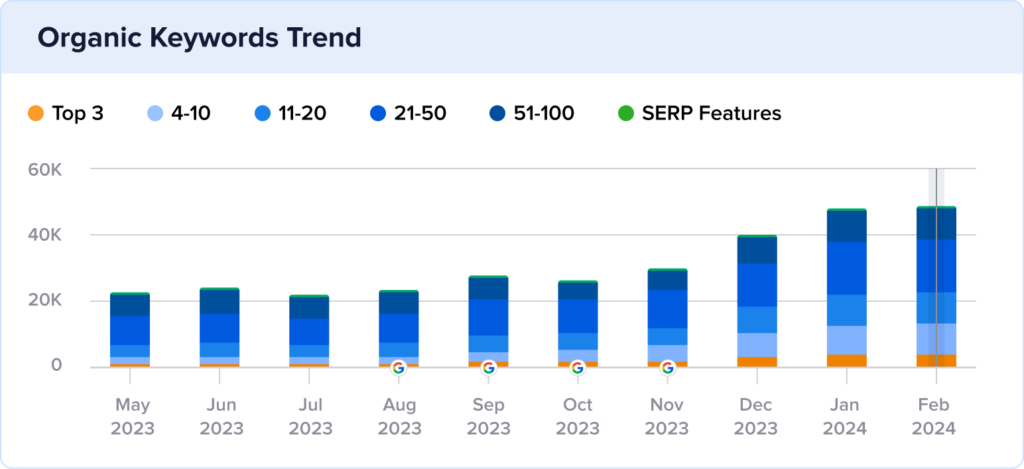
In addition to ranking for more keywords than ever, VIVO had higher positions on the search engine results page (SERP).
The side-by-side comparison below demonstrates how VIVO had 659% more rankings in the top 3 results in February 2024 than in August 2023.
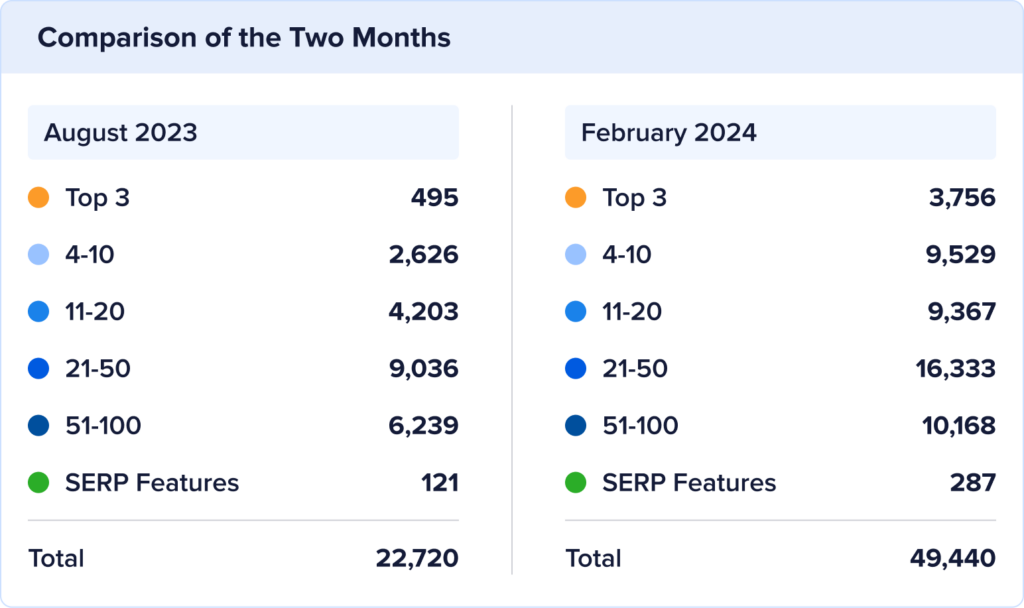
Typically, this type of growth wouldn’t be surprising if VIVO had invested in its content strategy. After all, the more content you publish, the higher your chances of ranking.
However, that wasn’t the case. The page count was only slightly higher due to product turnover.
It’s also worth noting that as we analyzed this website in March, we noticed that organic performance is starting to trend downward. Google is currently rolling out another update, which could be impacting the site’s performance.
With that said, it’s still early on, and March is only an estimate thus far.
Why this matters:
Every website is vulnerable to fluctuations in rankings from algorithm updates. That's why it's important to monitor your SEO performance and keyword rankings. By understanding how your site performs in organic search, you'll be able to spot changes following algorithm updates.
How to monitor SEO performance:
The easiest way to monitor the impact of Google algorithm updates is by using an SEO plugin.
The linked tutorial shows how you can stay on top of your rankings, but here’s a recap of the process:
- Install All in One SEO (AIOSEO).
- Open Search Statistics.
- Navigate to the SEO Statistics tab.
- Compare changes in performance around algorithm updates.
Tools for SEO performance:
AIOESO Search Statistics makes it easy to track your site's organic performance.
You’ll get a timeline view that shows key metrics like impressions, clicks, and position. You’ll also see Google algorithm markers that allow you to pinpoint when an update could have affected your site.

Each marker has a read more option to learn about the update. These insights can help you uncover which factors contributed to your site’s change in performance.
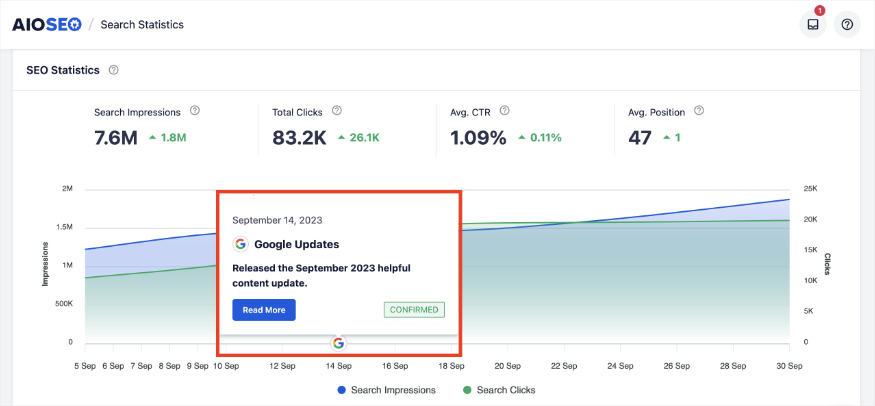
Even though algorithm updates are out of any website’s control, VIVO uses SEO best practices to support its organic growth.
We’ll look at those strategies next.
2. Review Snippets on the Rise
Between August and February, VIVO more than doubled its rankings with review snippets.
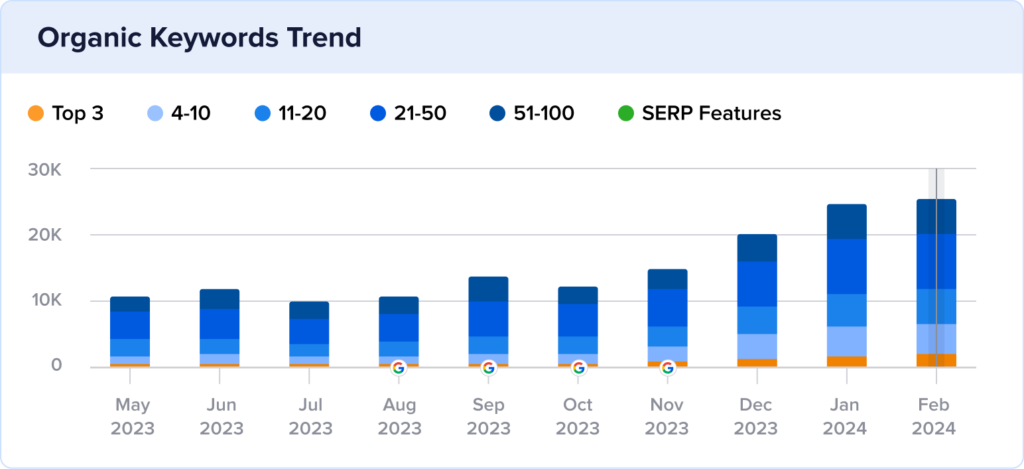
Review snippets are a type of rich result that shows customer ratings and reviews directly on the SERP.
Here’s what one looks like in search results:
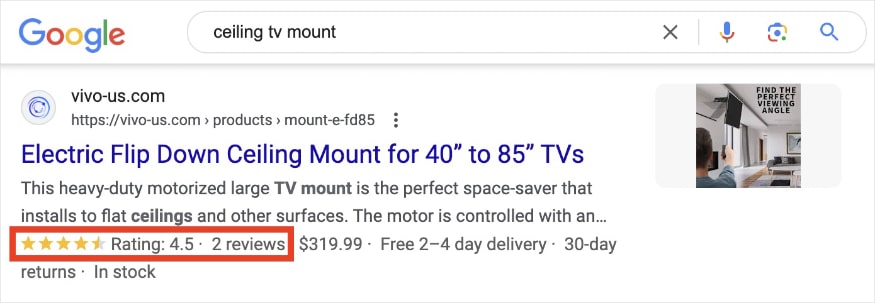
And with over 22K rankings of these eye-catching search results, it begs the question: How did VIVO get them?
That’s the power of schema markup.
Schema markup is specialized code that gives search engines helpful information about a web page. It's easy for search engines to understand, which is why many website owners use it to communicate their site’s content.
There are several types of schema markup, and each can help you win a rich result on the SERP.
Note: Implementing schema markup does not guarantee a rich snippet. However, it's considered an SEO best practice to include it. It can also increase the likelihood of getting these covetable search listings.
In VIVO’s case, they use schema markup specifically designed for reviews. They use product schema and aggregate rating schema.
It looks like this in the product page’s source code:
{"@context":"http://schema.org","@type":"Product","@id":"https://vivo-us.com/products/mount-e-fd85#product","name":"Electric Flip Down Ceiling Mount for 40” to 85” TVs","aggregateRating":{"@type":"AggregateRating","ratingValue":"4.50","reviewCount":2}}This markup allowed search engines to display star ratings and review counts directly on the SERP. As a result, it makes their listings more appealing and informative to potential customers.
Why this matters:
Highlighting positive customer ratings is a powerful way to drive more traffic to your site.
2024 SEO statistics reveal that rich snippets receive 58% of all clicks. This is substantially higher than standard search results, which have a 41% clickthrough rate (CTR).
Review snippets are a great way for eCommerce sites to stand out from the competition and build trust with new customers.
How to get review snippets:
WordPress users can follow this tutorial to implement schema markup without a plugin. It requires basic coding knowledge and uses JSON-LD.
To get the code, you can use Google’s Structured Data Markup Helper or the JSON-LD Playground. You’ll want to select Product in each tool.
Tools for product schema markup:
Want to skip the coding and jump straight to winning rich snippets?
A product reviews plugin streamlines the markup process, so you can start ranking with rich results—fast.
AIOSEO’s Schema Generator allows you to pick from a catalog of schema types and formats the structured data for you. Simply, select Product from the list, answer a few questions, and add your reviews.
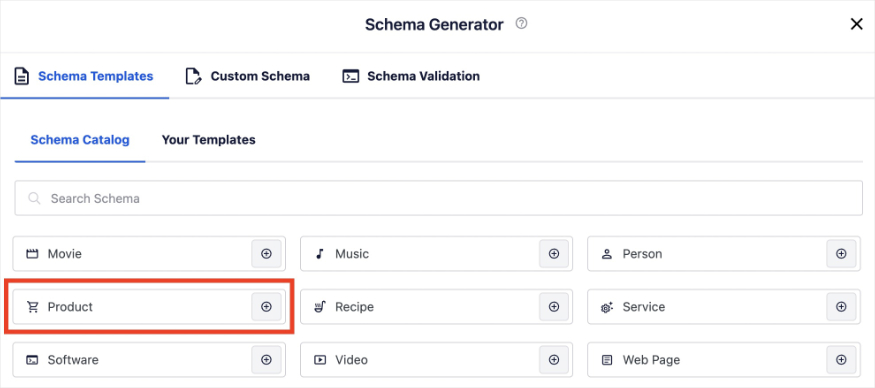
Now, let’s see how images influence VIVO’s presence on the SERP.
3. Images Capture Clicks
Images have been another key factor in VIVO standing out from the online competition.
In fact, images have experienced even more growth on the SERP than review snippets.
In February 2024, ranked for 27.7K keywords with images. That’s triple the amount of rankings in August.
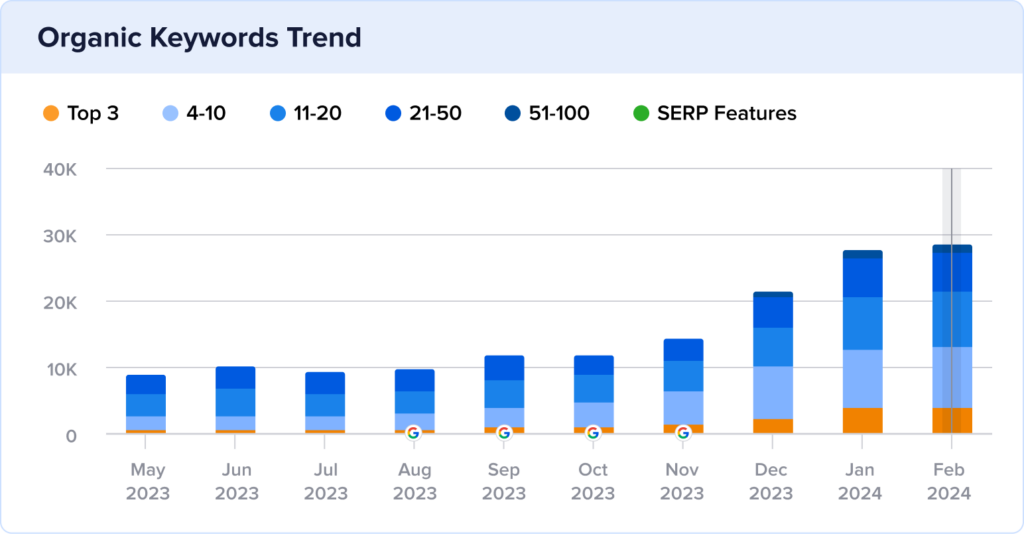
Images can go hand-in-hand with product schema because you typically have an image of the item you’re selling. Google often uses these images in search results, as seen below.

Images can also extend beyond product and collection pages and go for virtually any graphic element on your site.
Now, the tricky thing about images is that search engines can’t “see” images in the same way humans do. Instead, they rely on text to understand the content of images.
This process of optimizing your images for search engines is called image SEO.
Image SEO helps search engines understand your images, which can help them rank in search results.
And, as we saw with review snippets, rich results (including images) have one of the highest CTRs.
For VIVO, they use the following image SEO techniques to win these click-worthy search results:
- Image filenames contain the primary keyword.
- Alt text is natural and descriptive.
- They use image schema markup.
Why this matters:
In today's digital landscape, visuals are key to capturing users' attention and driving engagement. Image SEO can help you gain more visibility on the SERP, leading to higher clickthrough rates and more organic traffic.
Image optimizations can also help you rank in Google Images, where there are over 1 billion searches every day.
How to do image SEO:
In addition to the steps we mentioned earlier, you can also use the following techniques to master your image SEO:
- Create an image sitemap.
- Compress images to reduce their file size.
- Use your primary keyword in the image title tag.
For even more tips, visit this WordPress guide on optimizing images.
Tools for image SEO:
Image SEO can be time-intensive when you don’t have the right tools.
At AIOSEO, you can minimize the manual work and maximize the efficacy of your image optimizations with our Image SEO module.
This tool comes with smart tags, which you can use to customize and automate image attributes, like titles, alt tags, and captions.

And if you’re using product schema like VIVO, you can also upload an image. The Schema Generator will automatically format your structured data for search engines, boosting your chances of more image rankings.
Standout SEO Wins
Before we wrap up, we noticed an additional SEO technique we’d like to highlight at vivo-us.com.
Canonical Tags and Noindex Directives Prevent Duplicate Content Issues
As an eCommerce, it's not uncommon to have multiple pathways for customers to reach the same product page. For example, if a user is shopping for a standing desk, they might access it through category pages, search results, or promotional banners. Each pathway may generate a unique URL, leading to duplicate content.
Search engines struggle with duplicate content because they don’t know which page to rank.
VIVO tackles this challenge by using canonical tags and noindex directives.
Canonical tags tell search engines which URL is your preferred version of a web page. In other words, it lets them know which one you want to rank in search results.
In the example below, I reached the first URL by looking for a desk in the Small Spaces Collection. We see this collection in the first, longer URL.
However, VIVO uses the main product page (the second URL) as its canonical URL. This tells search engines that VIVO prefers the /products/cart-v089 page and wants it to rank (and not the first URL).
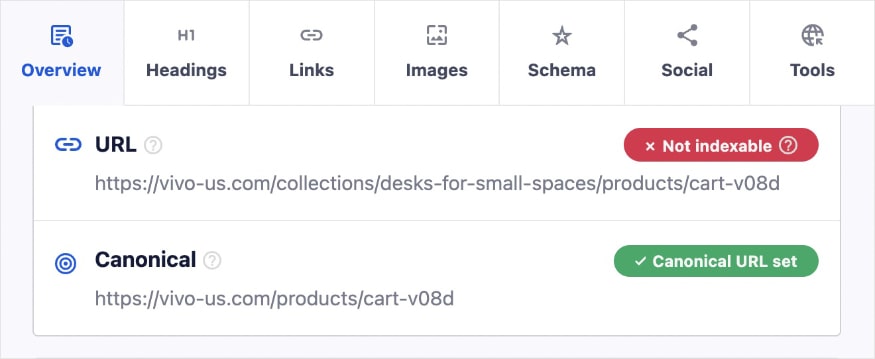
Note: The above screenshot was taken from the All in One SEO Analyzer. This free Chrome Extension allows you to perform quick SEO analyses of your website and those of competitors.
VIVO reinforces its canonical tage by also setting a noindex directive for the first URL. This tag prevents content from showing in search results.
Tool: You can easily set canonical tags and noindex directives in AIOSEO. For canonical tags, simply enter the URL of the page you want to rank in the AIOSEO Settings.

For noindex tags, you can also switch off the Default Settings to turn on a noindex directive for a page.

Takeaways
In our analysis of VIVO, we’ve discovered how keeping a pulse on search performance and a few technical optimizations helped them grow organic traffic.
Now, let’s see which strategies to use on your website and others to reconsider.
Top 3 Strategies to Emulate
- Monitor the effects of Google algorithm updates. Analyzing your content's performance will allow you to recognize the impacts of algorithm updates. It's important to keep an eye on important metrics such as keyword rankings and impressions to detect changes and adapt your strategies as needed.
- Use product and aggregate rating schema to win review snippets. Utilizing schema markup is an effective method for generating rich snippets. In eCommerce, ratings and reviews carry significant weight as they show the value of your product to potential customers on the SERP. Star ratings, in particular, attract attention and can boost your CTR.
- Leverage image SEO to get click-worthy rich results. Image SEO enhances search engines' understanding of your content's visual elements. This can ultimately help your images rank in both standard search results and Google Images, both of which drive significant organic traffic.
Bottom 3 Strategies to Reconsider
- Not setting an H1 on every indexable page. The H1 heading is crucial in providing context to users and search engines about the main theme or topic of the page. By omitting the H1 tag, you miss out on the opportunity to clearly communicate what your page is about, impacting its discoverability and user comprehension. The TruSEO tool checks your H1 for your keyword, so if you forget your keyword or the H1 altogether, it makes it easy to catch it.
- Duplicating or omitting meta descriptions. When you use the same meta description across multiple pages, it confuses search engines and weakens the visibility of each page. Similarly, not setting a meta description results in search engines generating their own snippets, which may not be ideal. (Search engines also do this on their own, even if you have a meta description, but it's still a best practice to include one.) You can use a meta description generator to write optimized copy for you.
- Exceeding metadata character limits. Exceeding character limits can lead to cut-off page titles and meta descriptions in search results. This truncation can result in incomplete or unclear information, potentially reducing your CTR. It's important to adhere to character limits to ensure that your metadata represents your content and entices users to click. We recommend using a SERP preview tool to check how your metadata looks in search results before publishing.
Steal Our Winning SEO Strategy: A Checklist for Your Website
Download A Free SEO Checklist
Access our comprehensive SEO Checklist with a single click. We'll deliver it straight to you, putting actionable items with SEO tools and tutorials right at your fingertips.
Enter your name and email to download a free SEO checklist.
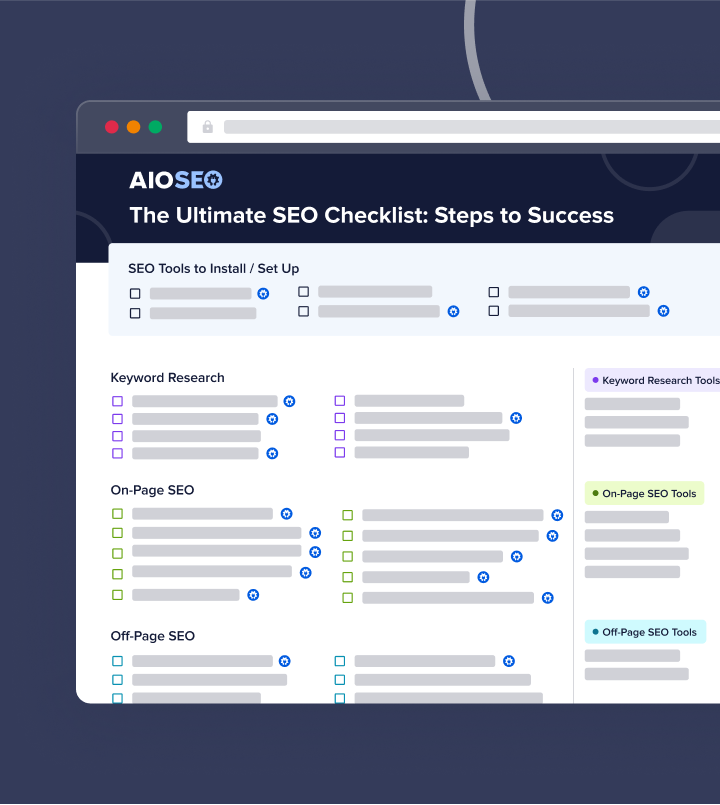
Unlock Higher Rankings and More Traffic With AIOSEO
Want to join the winning ranks of websites like VIVO?
You, too, can increase your keyword rankings and drive more users to your site. And with AIOSEO, it’s easier than ever.
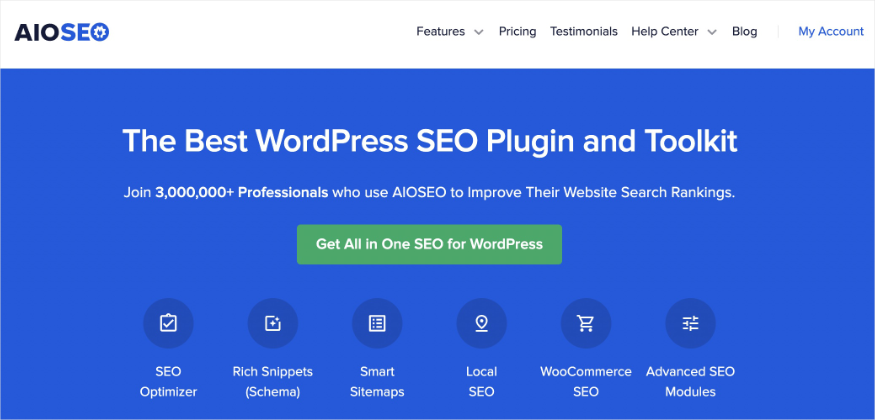
AIOSEO is the best SEO plugin for WordPress. With thousands of 5-star reviews and trusted by over 3 million website owners, you’ll be in good company as you take on the SERP. You’ll get the tools and guidance to simplify and optimize your SEO strategy for better results.
Here are a few of our favorite features:
- Search Statistics: Track your website’s organic performance with comprehensive and easy-to-understand reports. Search statistics include content decay tracking, allowing you to reinvigorate a page when it starts to slip.
- Rich Snippets Schema: AIOSEO offers various schema markup options to help you claim more rich results on the SERP. It’s as simple as choosing the schema you want; then, we’ll format the structured data for Google.
- Image SEO: Turn on automatic image alt text and title attributes with a single click. You’ll save time from manual entries while helping users and search engines understand your images.
- TruSEO Score: Get a snapshot view, or go into detail, of your content’s on-page SEO with this dynamic tool. TruSEO lets you know where you’re on target and gives you actionable items to make your content a home run.
- WooCommerce SEO: Streamline your eCommerce SEO to win higher rankings for your product pages and product collections. This time-saving tool helps you customize and automate meta titles and descriptions so your product stands out on the SERP.
- Robots.txt Editor: Control how bots crawl your site with the Robots.txt Editor, which allows you to override default WordPress settings. This tool makes it simple to view your robots.txt file and manage rules.

